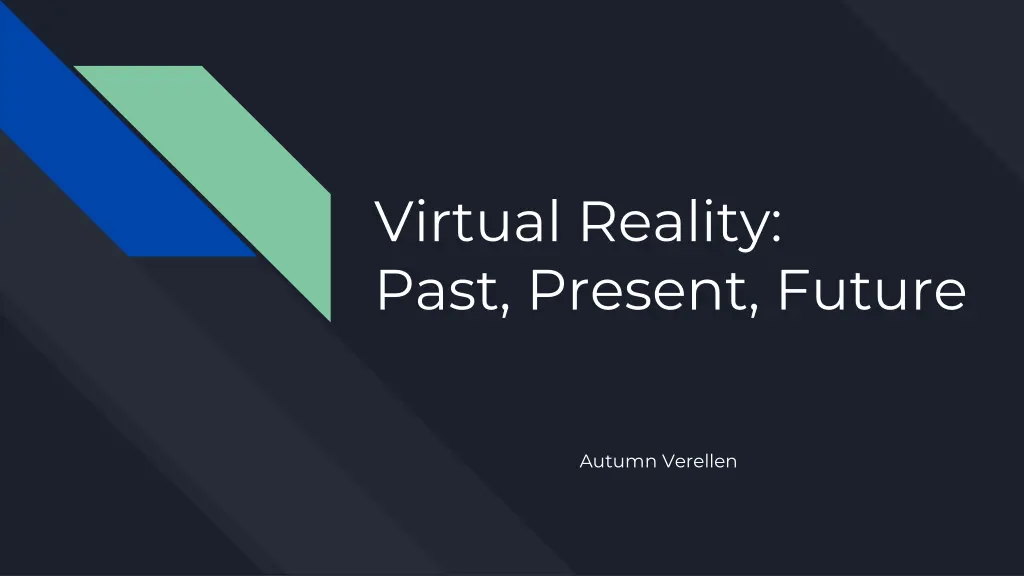
Evolution of Virtual Reality in Medical Procedures and Training
Explore the journey of virtual reality in the medical field, from past developments like the first flight simulator to present-day applications such as cardiologist training simulations. Witness how VR is revolutionizing surgical training, aiding in diagnosing ailments like broken arms, stomach issues, and more. Discover the benefits of VR simulators for surgeons and healthcare professionals, enhancing their skills and precision in diverse medical procedures.
Uploaded on | 0 Views
Download Presentation

Please find below an Image/Link to download the presentation.
The content on the website is provided AS IS for your information and personal use only. It may not be sold, licensed, or shared on other websites without obtaining consent from the author. If you encounter any issues during the download, it is possible that the publisher has removed the file from their server.
You are allowed to download the files provided on this website for personal or commercial use, subject to the condition that they are used lawfully. All files are the property of their respective owners.
The content on the website is provided AS IS for your information and personal use only. It may not be sold, licensed, or shared on other websites without obtaining consent from the author.
E N D
Presentation Transcript
Virtual Reality: Past, Present, Future Autumn Verellen
The Past Virtual Reality in 21st Century Panoramic Painting First Flight Simulator Virtual Reality Born Nintendo Virtual Boy Stereoscopic Photos First Head Mounted Display SEGA glasses The Matrix Movie
Medical Procedures Mr. Armbruster: - - - - - - Broken arm and would like to get well He goes to see a doctor Use of X-ray shows the break The doctor can then confirm The break is then casted Later X-rays show a healing
Medical Procedures Ms. Bauer: - - - - - - Extreme stomach pains Makes an appointment for ultrasound The doctor uses multiple viewpoints Comes to a diagnosis Diagnosis is then treated Ultrasounds confirm treatment worked https://radiopaedia.org/cases/grapes-in-stomach-ultrasound-findings-1
Cardiology Procedures - - Training can be very time consuming Surgeons must spend time training individuals for many years one on one Simulations of electrophysiology used in training - Reliant on the use of ultrasound and X-ray pictures Catheter insertion simulation is used in practice today - Capable of recording processing time - Passes information to the navigation - Updates information about user interactions - -
Benefits - - - - - - - - - Surgeons hone their knowledge and train quickly Surgical training is expensive and high pressure Rapidly gaining public recognition Ability to train a pilot in a simulator to operate high risk machine Optimal posture Accurately pick up utensils with appropriate instruments Placing utensils in relation with the tissue Accuracy of stitches Pace of surgery
Figure 3. Graph of Benefits of VR Simulators. Source: Konge, L., Clementsen, P. F., Ringsted, C., Minddal, V., Larsen, K. R., Annema, J. T. (2015). Simulator training for endobronchial ultrasound: A randomized controlled trial. European Respiratory Journal, 46(4), 1140-1149.
Immersion of Users - - - - Still commonly viewed as an element of science fiction User must be able to block out the outside world Immersion depends on vividness Breadth of Information achieved through collaboration of multiple media Computer must track movement and generate the sensory data Machine will be able to respond to spoken commands - -
Device Improvements - - - - - - - - Current quality is increasing constantly, but not accurate enough LCD screens must be improved Large projection screens can be used for better quality Tracking technology has many limitations The ideal tracker is small and lightweight The user s movement should be unbound Every input device should serve as an output device Allow users to perform manipulation tasks
